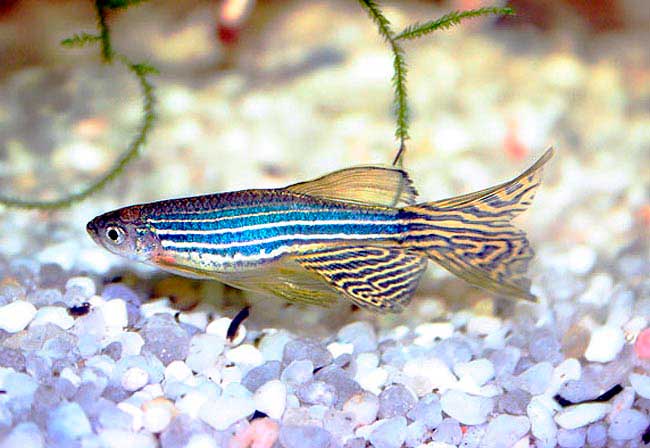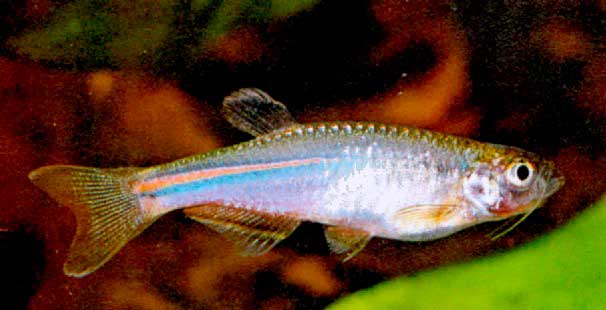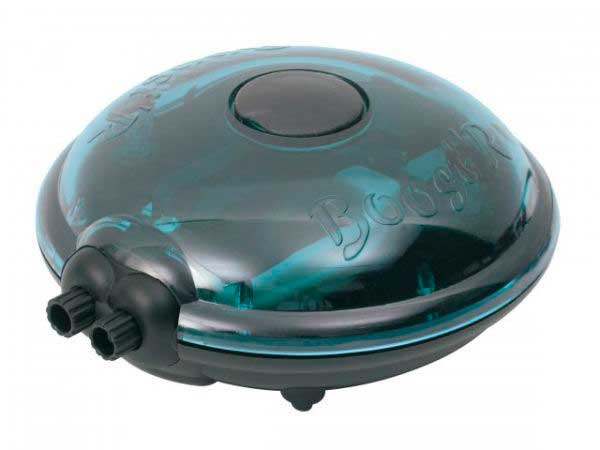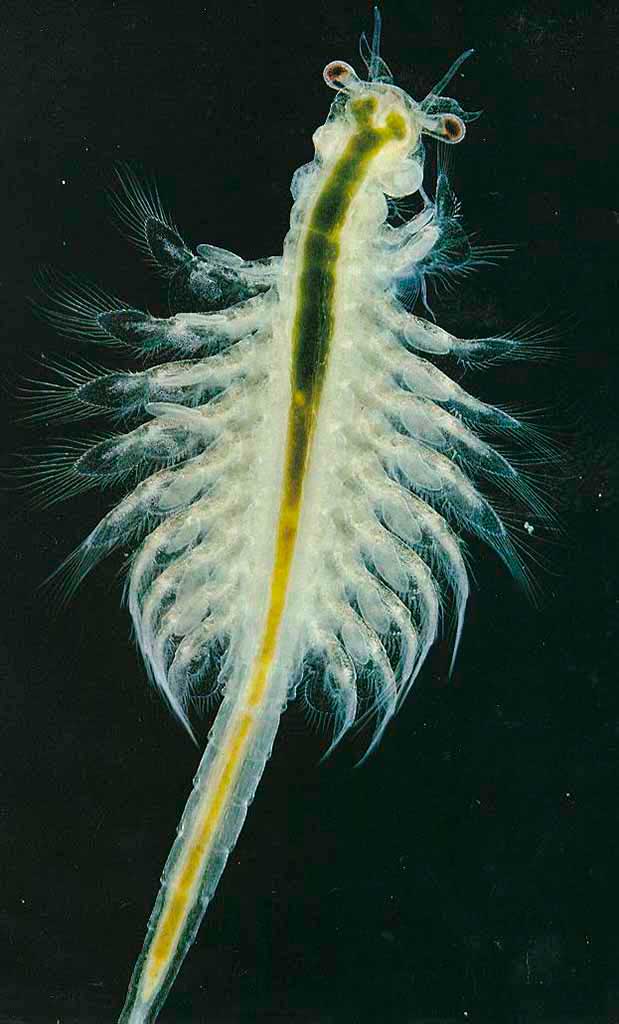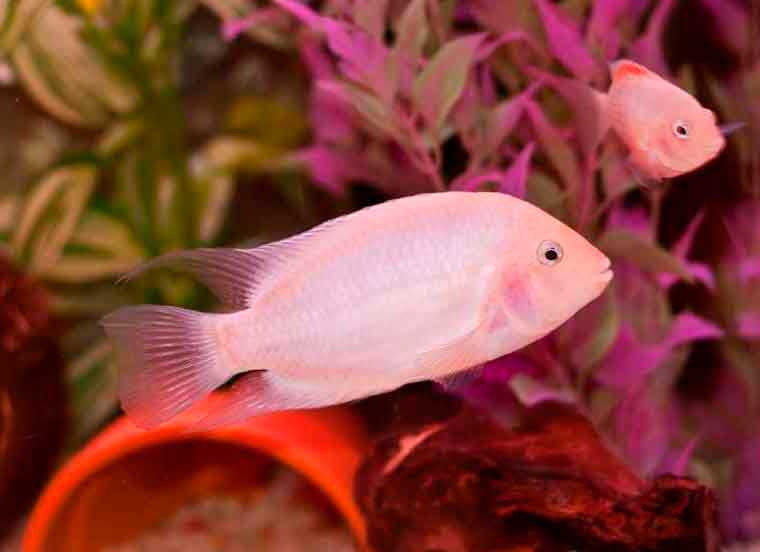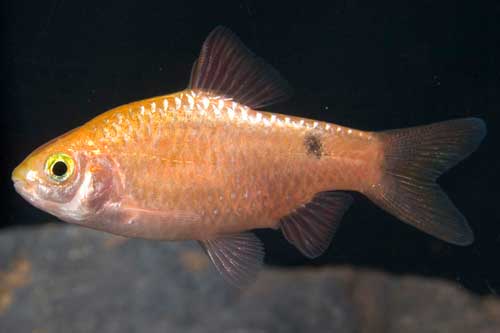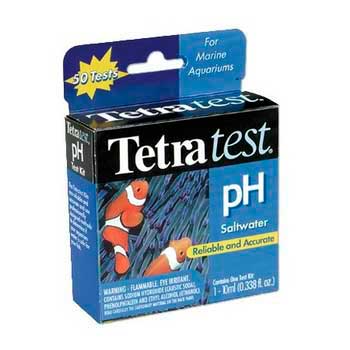The fish danio rerio belongs to the so-called model organisms of developmental biology. Due to the simplicity of maintenance, reproduction, high speed of embryo development it has become a kind of laboratory white mouse for ichthyology. It is one of the few living organisms that have visited space orbit.
Lat.: Danio rerio. Engl.: Zebrafish. Synonyms: brachydanio rerio.
The first description dates back to 1822. It was described by Hamilton. Fish danio rerio – an inhabitant of rivers, streams of the eastern coast of India, Pakistan, Bangladesh, Nepal, Myanmar, Bhutan. Russian aquarists first saw the fish around 1905-1906. It was reintroduced into the USSR around 1950.
In addition to the main name aquarists gave the fish a number of other affectionate nicknames such as “ladies’ stocking”, “stripes”, “danyushki”, “zebra”.
Description of Danio rerio
Fish danio rerio has an oblong-shaped body, along which go yellow-green alternating with dark blue stripes. At one time there were quite lively disputes – what color is the main, and what is additional.
| Kingdom | Animals |
| Phylum | Chordates |
| Class | Bony fish |
| Order | Carp |
| Family | Carp |
| Genus | Danio |
| Species | Danio rerio |
It is now considered to have a yellow-green coloration with a metallic sheen, with 4-5 dark blue stripes running along the body. This statement is confirmed by the existence of the leopard varietal.
In young representatives, the fins are short. But as they grow, they become voile. The fins give their owners a fairy-like appearance. The edges of the veil fins may have yellow coloration.
In the wild, adults reach 6-7 centimeters. Aquarium inhabitants, as a rule, 4.5 – 5 centimeters. It is desirable to keep at least seven to ten fish in flocks.
Males are slightly slimmer than females and also have more intense colors. Females have a more rounded abdomen, especially after puberty.
Held most of the time in the middle, upper layers. Life expectancy is about three years. Sometimes live up to five years if well kept. They become sexually mature at six to eight months of age.
Breeding forms of Danio rerio
with veil fins
A species with longer pectoral and caudal fins than the natural form. Breeders have managed to fix this mutation at the genetic level.
leopard color
The leopard species has a body studded with dark spots. The spots resemble the coloring of a leopard. This coloration gave the name to this breed. Although some ichthyologists tend to consider this species a separate species. But among the inhabitants of the wildlife it is not. At least according to the data I’ve been able to find. It is more likely, therefore, that the leopard coloration is the result of the work of breeders.
Fluorescent transgenic “GloFish”
In 2003, a genetically modified breed, the fluorescent breed, appeared on the world market. The first fluorescent “GloFish” was obtained by implanting a fragment of jellyfish DNA with the ability of biofluorescence into the DNA of a danio rerio embryo.
The first GloFish was green in color. Today the following varieties are known: Starfire Red, Electric Green, Sunburst Orange, Cosmic Blue, Galactic Purple. All of these varieties have been genetically engineered.
In Canada and European Union countries it is illegal to keep, breed, sell, exchange genetically modified objects (organisms)!
Keeping conditions of Danio rerio
The danio rerio fish is an unpretentious, peaceful, freshwater fish.
The hardness of the water is of no particular importance. The pH reaction should preferably be closer to neutral. It can withstand temperature fluctuations from 15 to 30 degrees Celsius.
To the volume of the vessel are not demanding. Even a three-liter jar will be a good home for three to four individuals. Although of course three-liter bottle should be considered only as a temporary replacement for the aquarium. It is better for a flock of ten individuals to equip a normal permanent home of ten to fifteen liters. It will take a little more space than the bank, but will look much better. In addition, it will be easier to care for your pets.
Aquarium decoration
The bottom should be covered with a layer of granite crumbs or small stones. The soil can be coarse river sand. It is better for the soil to be of a dark color.
Long-leaved plants are preferable – vallisneria, geleocharis, sagittaria, cabomba, myriophyllum. Plants should be planted along the back and side walls, necessarily leaving space for swimming.
Danio rerio is a restless creature, very impetuous. Sometimes accelerated, properly, in the direction of upward, she, playing, can jump out of the aquarium. In the wild so amuse themselves, it must be fun. Jump up high and a little flying again plunge into their native element.
In the room, such flights end miserably with a hard landing on the floor. If there is no person nearby who is able to correct piloting errors in time, the matter will end badly. Therefore, the vessel with these fish should be equipped with a lid or at least covered with a glass of suitable size.
It is desirable to contain at least 7-10 pieces. Danio rerio fish are compatible with virtually any other peace-loving fish with similar conditions (other representatives of the genus Danio, guppies, swordfish, rasboras, tetras, barbs).
Recommended environmental parameters for maintenance
| dH | 7-9° |
| t | 21 -25°С |
| pH | 7 |
Feeding
They eat any food, but prefer live food. Better small crustaceans, such as daphnia, cyclops. Small moths are also suitable. A treat for them is also chopped meat. Allow you to feed dry not large feed, preliminarily slightly rubbed them with your fingers. Feed danio rerio easier to take from the surface of the water or catch in its thickness.
Danio rerio breeding
Reproduction also goes without much difficulty. But the fish ‘this – spawning. Therefore, without prior preparation can not do without.
About a week before spawning, it is necessary to separate males from females and keep them apart from each other. The female can be distinguished from the male by a more rounded abdomen and less saturated coloration of yellow-green stripes. Before spawning, spawners should be abundantly fed, preferably bark.
Set up a spawning ground
Spawning can be an aquarium of 10 liters (in extreme cases – a regular three-liter jar). Cover the bottom with shiny, pistolistnika or fontinalis. I also had positive results with ordinary elodea. Plants are slightly pressed with small stones, so that they do not rise to the surface. You can also use a grid, which has cells of such a size that through them freely passed the eggs. But its cells should be tight for the producers.
The water should be freshly tempered for at least 2 days. The temperature is 24 – 26 degrees Celsius. It is poured in a layer of about 5 centimeters above the plants.
Нерест
From the evening in the spawning tank prepared in this way put two males (can be three) and one female. The readiness of the female to reproduce is indicated by a thickened abdomen near the anal fin. The tank is placed on a well-lit window. Danio rerio breeding begins in the morning when the first rays of sunlight fall on the spawning ground. The female can sweep out at one time from 50 to 400 eggs.
If spawning did not occur first morning, producers should be kept in the spawning tank for another day feeding small moths. If even now spawning has not been. The males should be separated from the females and after 3-4 days again put on spawning.
There is one peculiarity – if the spawned female is not planted again to spawn in 7-10 days, she may lose the ability to reproduce.
After the end of spawning, producers should be dropped off, and half of the water should be replaced with fresh, tempered, the same composition, the same temperature.
What to feed the fry?
After about 3-4 days, larvae emerge from the eggs and hang on the glass of the jar for several days. They look like threads with thickened heads. After a few days, the fry begin to swim. As soon as the fry swim they need to give infusoria, rotifers, nauplii artemia. If the fodder is quite tense situation, you can feed boiled in steep diluted water diluted egg yolk. Only need to give it very carefully in small portions, as it is very strong spoils the aquatic environment. The results will be somewhat worse.
As the fry grow, the food for them can and should be enlarged. Small crustaceans such as daphnia, cyclops can be given to mature fry. Growing fry as they grow should be transferred to a larger vessel.
As you can see, this representative of the underwater kingdom can become a worthy decoration of the general aquarium novice aquarist. A flock of these fidgets can revitalize any underwater landscape. Danio rerio fish resistant to disease. If you do not create extreme conditions, they will long please your eyes with their endless game.
